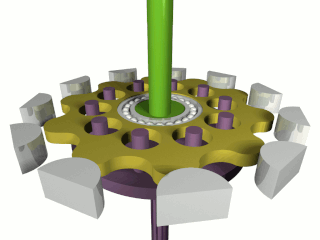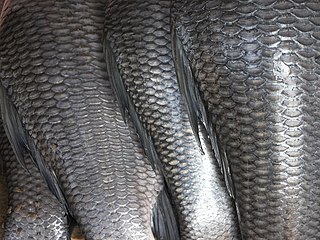
Perciformes, also called the Acanthopteri, is an order or superorder of ray-finned fish in the clade Percomorpha. Perciformes means "perch-like". Among the well-known members of this group are perch and darters (Percidae), sea bass and groupers (Serranidae).

In zoology, a scale is a small rigid plate that grows out of an animal's skin to provide protection. In lepidopterans, scales are plates on the surface of the insect wing, and provide coloration. Scales are quite common and have evolved multiple times through convergent evolution, with varying structure and function.

In geometry, a cycloid is the curve traced by a point on a circle as it rolls along a straight line without slipping. A cycloid is a specific form of trochoid and is an example of a roulette, a curve generated by a curve rolling on another curve.
The following is a timeline of classical mechanics:

Fish anatomy is the study of the form or morphology of fish. It can be contrasted with fish physiology, which is the study of how the component parts of fish function together in the living fish. In practice, fish anatomy and fish physiology complement each other, the former dealing with the structure of a fish, its organs or component parts and how they are put together, such as might be observed on the dissecting table or under the microscope, and the latter dealing with how those components function together in living fish.

Labrisomids are small blennioids (blennies), percomorph marine fish belonging to the family Labrisomidae. Found mostly in the tropical Atlantic and Pacific Ocean, the family contains about 110 species in 15 genera.

Clinidae is a family of marine fish in the order Blenniiformes within the series Ovalentaria, part of the Percomorpha. Temperate blennies, the family ranges from the Atlantic, Pacific, and Indian Oceans, in both the Southern and Northern Hemispheres. The family contains about 86 species in 20 genera, the 60-cm-long giant kelpfish being the largest; most are far smaller.

In the differential geometry of curves, the evolute of a curve is the locus of all its centers of curvature. That is to say that when the center of curvature of each point on a curve is drawn, the resultant shape will be the evolute of that curve. The evolute of a circle is therefore a single point at its center. Equivalently, an evolute is the envelope of the normals to a curve.

Sweepers are small, tropical marine ray-finned fish of the family Pempheridae. Found in the western Atlantic Ocean and Indo-Pacific region, the family contains about 26 species in two genera. One species is the target of subsistence fisheries in Japan, where the fish is much enjoyed for its taste. Sweepers are occasionally kept in marine aquaria.
Aristotle's wheel paradox is a paradox or problem appearing in the pseudo-Aristotelian Greek work Mechanica. It states as follows: A wheel is depicted in two-dimensional space as two circles. Its larger, outer circle is tangential to a horizontal surface, while the smaller, inner one has the same center and is rigidly affixed to the larger. Assuming the larger circle rolls without slipping for one full revolution, the distances moved by both circles' circumferences are the same. The distance travelled by the larger circle is equal to its circumference, but for the smaller it is greater than its circumference, thereby creating a paradox.

A cycloidal drive or cycloidal speed reducer is a mechanism for reducing the speed of an input shaft by a certain ratio. Cycloidal speed reducers are capable of relatively high ratios in compact sizes with very low backlash.

Exocoetus is a genus of flying fishes. It is a bony fish. The body is covered with cycloid scales. The mouth is wide, and the jaws bear teeth. It is a marine fish. The tail has hypobatic fins as the ventral lobe.

Leptolepidae is an extinct family of herring-like stem-teleost fish found throughout the world during the Jurassic. They were among the first fish to possess certain teleost synapomorphies, such as cycloid scales and fully ossified vertebrae.

In geometry, Cavalieri's principle, a modern implementation of the method of indivisibles, named after Bonaventura Cavalieri, is as follows:

A fish scale is a small rigid plate that grows out of the skin of a fish. The skin of most jawed fishes is covered with these protective scales, which can also provide effective camouflage through the use of reflection and colouration, as well as possible hydrodynamic advantages. The term scale derives from the Old French escale, meaning a shell pod or husk.
Paraclinus fasciatus, the banded blenny, is a species of labrisomid blenny native to the Atlantic Ocean including the Gulf of Mexico and the Caribbean Sea from southern Florida to Venezuela. The banded blenny is a marine organism, meaning it lives in an aquatic environment. This species lives in the vicinity of coral reefs preferring sea grass beds in shallow waters down to 2 metres (6.6 ft). Although they are typically located in shallow waters, their colors camouflage them exceptionally well, leading to them rarely being seen or recognized. They have also been found within floating algae.
The obscure snakehead is a medium-sized carnivorous fish that has an elongated shape tapered on both ends and is covered in medium circular scales (cycloid). The head, resembling a snake, is long and depressed anteriorly and covered with cycloid scales slightly larger than those scales on the body. This species is found in central Africa along the western coastline from as far north as Senegal to as far south as Zaire and into central Africa into southwest Sudan.

Horologium Oscillatorium: Sive de Motu Pendulorum ad Horologia Aptato Demonstrationes Geometricae is a book published by Dutch mathematician and physicist Christiaan Huygens in 1673 and his major work on pendula and horology. It is regarded as one of the three most important works on mechanics in the 17th century, the other two being Galileo’s Discourses and Mathematical Demonstrations Relating to Two New Sciences (1638) and Newton’s Philosophiæ Naturalis Principia Mathematica (1687).

The Pseudaminae is a subfamily of ray-finned fishes, one of two subfamilies of the family Apogonidae, the cardinalfishes. They are characterised by having large caniform teeth which are placed on the on dentary and premaxillae, by having the lateral line absent or incomplete, by having no scales or if scales are present they are cycloid. One species, Gymnapogon urospilotus, is notable for its larvae being rather large and fast-swimming.














